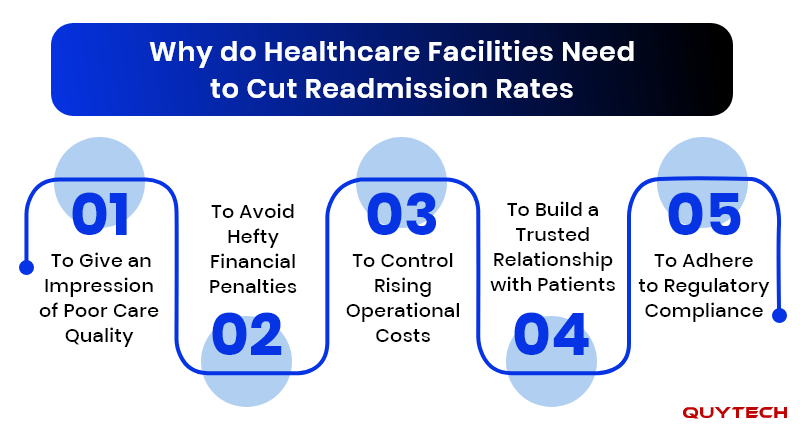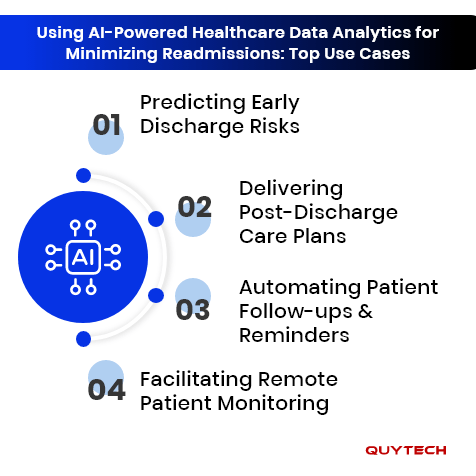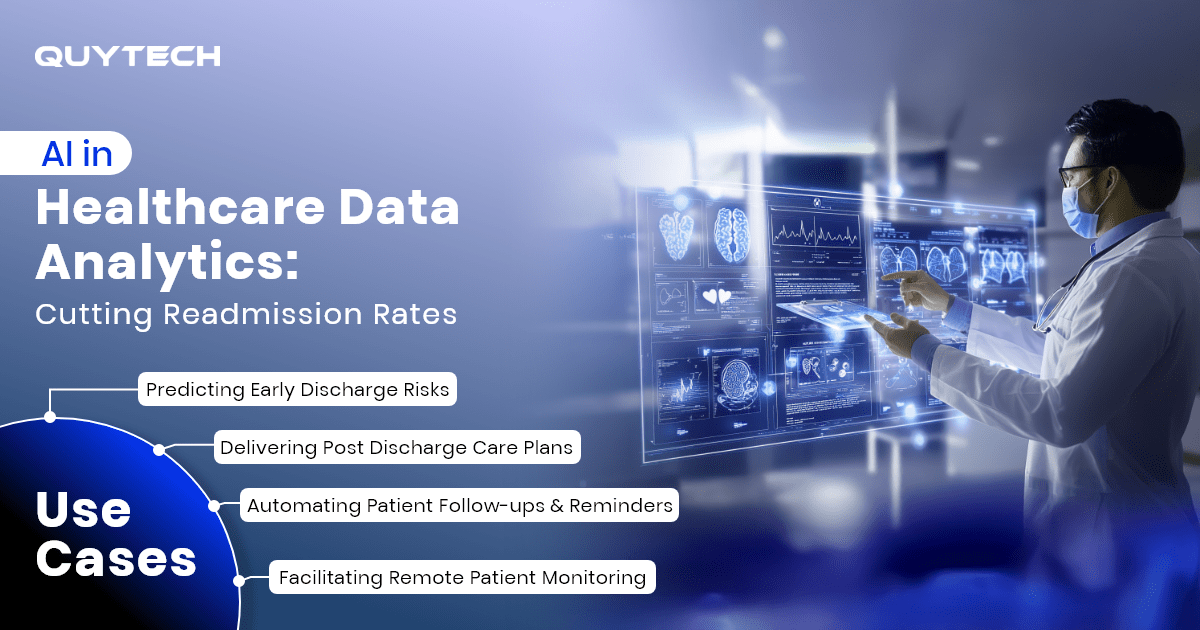A patient is discharged after spending a week in your hospital. It’s just been a fortnight since his discharge, and he comes back for readmission. Imagine happening this every now and then. These unplanned readmissions may burden your healthcare system, incur significant costs, and frustrate patients. It can also give the impression that there is a breakdown in post-discharge care.
What if we tell you that there is a simple and effective solution to this problem? Sounds amazing, right? We are talking about AI in healthcare data analytics that lowers readmission rates.
But how can implementing merely a technology help? Well, this is the magic of artificial intelligence-powered data analytics. It makes the most of your patient data to identify high-risk patients before their discharge from the hospital or a healthcare setting.
Not just highlighting patients, implementing AI data analytics in healthcare can even predict possible post-discharge complications and suggest personalized care plans to cut readmission rates. Let’s dig deeper into this blog to learn how:
What is AI in Healthcare Data Analytics
These days, healthcare organizations rely upon multiple software and healthcare management systems, like Electronic Health Records, to manage patients. These systems store vast amounts of data from patients’ lab results, surveys and feedback, medical history, and more. Going through this data and making sense out of it using traditional ways is like finding a needle in a haystack.
However, doing the same with data analytics is totally different. It requires zero to minimal manual effort while processing the stored patient data at a lightning-fast speed to offer accurate insights for smarter and personalized treatment plans and decision-making.
In case of hospital readmissions, mainly that happens within the 30 days of discharge, which is one of the costliest things for hospitals in the United States of America, AI data analytics in healthcare identify patterns and risk factors that may go unnoticed with manual analysis. Data analytics can flag patients with higher chances of returning to the hospital. It takes into account patients’ clinical data, behavioral and lifestyle data, and social determinants of health, along with the hospital’s operational data for a readmission analysis.
Why do Healthcare Facilities Need to Cut Readmission Rates

Readmissions negatively impact the reputation of a hospital. To lower this rate, hospitals, mainly in the USA, are implementing “Hospital Readmissions Reduction Programs (HRRP).”
The prime goal of HRPP is to improve patient care and lower healthcare expenses by preventing a hospital from paying fines in case of considerably higher readmission rates. Let’s explore some other reasons why hospitals need to focus on cutting readmission rates.
#1 To Give an Impression of Poor Care Quality
A high rate of readmissions means the hospital is not delivering the right patient care or there are gaps in the patients’ treatment and post-discharge care. On the other hand, lower rates are a sign of better care coordination.
#2 To Avoid Hefty Financial Penalties
Most countries, including the USA, impose financial penalties on healthcare facilities with frequent readmissions. In America, these penalties are imposed under a plan called HRPP that is developed by the Centers for Medicare & Medicaid Services (CMS). These fines affect margins and cause significant revenue loss for hospitals.
#3 To Control Rising Operational Costs
When a patient readmits, the hospital requires resources and infrastructure to look after them. Minimizing the chances of readmission cuts the operational cost and ensures optimal utilization of the hospital’s capacity.
#4 To Build a Trusted Relationship with Patients
A patient being admitted to the hospital frequently goes through emotional and physical distress. They may even doubt the care being given. By minimizing the chances of readmissions, hospitals build a trusted relationship and ensure complete patient satisfaction.
Similar Read: How Healthcare Apps Improve Patient-Doctor Communication?
#5 To Adhere to Regulatory Compliance
Healthcare regulators and accreditation bodies have added readmission rate as a critical parameter to measure the performance of a hospital. Reduced readmission rates mean a good reputation and adherence to defined compliance.
How Does AI Data Analytics Reduce the Rehospitalization Rate
Besides AI data analytics, several subsets of AI work hand-in-hand to analyze structured and unstructured patient data to identify high-risk patients and forecast patient returns to recommend early intervention and deliver more personalized care. Here’s how:
#1 Predictive Analytics
Well-trained AI models analyze data from various sources, including data from the electronic health record system, patients’ clinical reports, discharge summaries, and others, to predict the likelihood of their admissions within a specific period. Based on this, hospitals can take the required steps and ensure focused care to avoid returns.
Similar Read: How Predictive Analytics is Transforming Healthcare Industry
#2 Machine Learning
ML enables AI data analytics to look into historical data and improve itself continuously to predict better results or forecast the chances of patients’ rehospitalization. Apart from this data, it also takes into account various patterns like adherence to medication.
#3 Natural Language Processing
NLP plays a critical role in processing data, especially unstructured data. This could be doctors’ prescriptions, discharge instructions, and others. By analyzing this data, it enables the data analytics system to offer useful insights about how likely the patient will be readmitted.
#4 Real-Time Risk Scoring
By integrating artificial intelligence data analytics into an EHR system, hospitals can collect real-time risk scoring for every patient at the time when they are receiving care. This can facilitate proactive intervention to ensure better pre-discharge care.
You may also like to read: How AI Is Transforming the Healthcare Industry: Discover the Top Ways
Using AI-Powered Healthcare Data Analytics for Minimizing Readmissions: Top Use Cases

Now that you know enough about AI healthcare data analytics for healthcare, it’s time to explore the areas where data analytics in healthcare can be implemented to achieve the goal, i.e., lower rehospitalization rate:
#1 Predicting Early Discharge Risks
One of the ways AI data analytics in healthcare can reduce readmission frequency is by assessing the possibility of it. It’s done before a patient gets discharged from the hospital. Data analytics look into the patient’s clinical data, current condition, and pace of recovery, and suggest whether the patient is fit to be discharged or requires additional care support.
#2 Delivering Post-Discharge Care Plans
AI data analytics in healthcare not only analyzes patient data, but it can even help healthcare professionals design post-discharge care plans as per every individual patient’s health condition and risk factors. It can help with medication management, exercise, and mental health management.
#3 Automating Patient Follow-ups and Reminders
AI data analytics solutions for healthcare can be seamlessly synchronized with AI chatbots and SMS systems to automatically remind patients to take their medications on time and also alert medical professionals about any critical situation.
#4 Facilitating Remote Patient Monitoring
Healthcare data analytics solutions designed specifically to cut readmission frequency can also be connected with wearables and IoT devices to continuously monitor patients remotely. They can track vitals and transmit data based on which the AI data analytics solution can flag early signs of complications for a proactive intervention and minimize the chances of rehospitalization.
Read More: AI in Remote Patient Monitoring: Improving Healthcare Accessibility and Convenience
Benefits of Using AI in Healthcare Data Analytics for Reducing Rehospitalization
Implementing AI data analytics in healthcare can reduce the chances of patients’ return. This can benefit the hospitals and patients in the following ways:
#1 Better Patient Outcomes
AI models and data analytics together can detect early signs of health deterioration in patients. Based on this, healthcare professionals can deliver proactive care, rather than taking action later. It ensures better patient outcomes.
Read More: AI in Healthcare: Drives Potential Enhancements across the Healthcare Sector
#2 Optimized Resource Allocation
Unplanned readmissions can impact the hospitals’ resource and infrastructure management plans. Using AI data analytics for reducing rehospitalizations can prevent this. It flags high-risk patients and enables hospitals to prioritize their resources efficiently.
#3 Regulatory Compliance Alignment
Healthcare systems and regulatory authorities in most countries have implemented various programs that aim to reduce readmissions. They impose heavy penalties on hospitals with high readmissions. AI data analytics helps align with these compliance by identifying at-risk discharges and making caregivers modify healthcare plans.
#4 Personalized Discharge and Follow-Up Plans
Using the power of artificial intelligence and data analytics, healthcare professionals can easily design post-discharge plans by ensuring higher adherence to the treatment or medication with regular follow-ups.
#5 Reduced Operational Costs
As aforementioned, unplanned rehospitalizations sometimes put pressure on the hospitals’ resources and infrastructure, which significantly increases the operational costs. By reducing readmissions, AI in healthcare data analytics minimizes this cost.
#6 Stronger Patient Engagement and Positive Reputation
Data analytics in healthcare connects with remote monitoring solutions to ensure that patients get medication reminders and adhere to given post-discharge care plans. This makes patients feel engaged. Reduced rate of rehospitalization also builds a positive reputation for the healthcare facility.
Explore More: Top Use Cases and Benefits of AI in Healthcare
Step-by-Step Process to Implementing AI Healthcare Data Analytics for Reduced Rehospitalization
Integrating AI data analytics in healthcare, mainly to lower readmission, requires in-depth expertise in AI, data analytics, machine learning, predictive analytics, and other similar technologies.
Besides, it needs one to analyze and understand the existing tech infrastructure, i.e., electronic health record systems, hospital and patient management systems, and others. Once you have all this, follow the steps below to implement AI in healthcare data analytics:
Step 1: Firstly, identify the type of readmissions you want to reduce. You can choose from 30-day readmissions, condition-specific readmissions, and others. Define how you will measure the outcome, i.e., the parameters like reduction percentage, improved patient follow-up, etc.
Step 2: Collect and analyze data from multiple (must be reliable) sources, like EHRs, lab reports, doctors’ prescriptions, patients’ demographics, lifestyle habits, data from wearables, medical history, etc.
Step 3: Implement ML algorithms and techniques to flag risk patterns and forecast the chances of readmission. Apart from this, integrate NLP to make the data analytics healthcare solution capable of analyzing doctors’ prescriptions, discharge instructions, and patients’ feedback.
Step 4: Now, categorize patients based on the risk factors. Enable real-time alerts (such as more frequent check-ins, medication changes, and others) and post-discharge care recommendations by integrating the AI models into existing hospital workflows or patient management systems.
Step 5: Monitor and update AI models on new patient data to improve their prediction precision and compliance with evolving laws and compliance. Don’t forget to track post-implementation performance by evaluating the models on pre-defined metrics.
Top Hospitals Using AI Data Analytics to Cut Readmissions
Check out some hospitals and healthcare providers that are using AI data analytics to reduce the frequency of patients’ readmissions:
#1 NYU Langone Health
This New York-based hospital has implemented an AI doctor that can predict the length of patients’ hospital stay, chances of their readmissions within a month, and other critical factors. It doesn’t require any structured data and can even read doctors’ prescriptions to provide outcomes.
#2 Corewell Health
Another US-based hospital that uses predictive analytics to reduce readmission rates. It has minimized 200 patient readmissions and saved $5 million by implementing this technology in their core tech infrastructure.
#3 Mission Health
Based in North Carolina, Mission Health uses a machine learning-based readmission risk model that efficiently and accurately predicts the frequency of rehospitalization for patients. The model helps the hospital save operational costs and build a positive reputation by delivering the best care.
How Quytech can Help You Implement AI-Powered Data Analytics
Quytech is a leading data analytics and service provider that builds AI-powered healthcare solutions using its expertise in AI, deep learning, ML, predictive modelling, and other technologies.
We have built 100+ data analytics solutions from zero to one for healthcare organizations of all sizes. Besides, we are also proficient in integrating AI data analytics in existing healthcare infrastructure to facilitate patient data collection and analysis to reduce readmission rates.
With our data analytics and AI expertise, we have delivered thousands of data analytics solutions to manufacturing, telecom, and other industries to help them transform their raw data into actionable insights for business benefits and improve customer experience.
You may like to read: Latest Healthcare Tech Trends in 2025 – Quytech Blog
Final Words
Higher readmission rates directly impact a hospital’s reputation and may also lead to paying financial penalties. Implementing AI-powered healthcare data analytics can cut rehospitalization by predicting the chances of patients’ return, identifying high-risk patients, and early-discharge consequences, and preparing post-discharge care plans.
AI data analytics in healthcare enables caregivers to deliver proactive healthcare services that improve patient outcomes while aligning with regulatory benchmarks. Give this blog a read to understand more about how AI healthcare data analytics is used to cut readmission rates.
If you wish to implement AI healthcare data analytics into your current technical infrastructure to reduce the rate of rehospitalization, connect with an experienced data analytics and services provider.
Frequently Asked Questions
While implementing AI data analytics to cut rehospitalization, one may face data privacy and security challenges, difficulty in integrating with legacy systems, and model transparency-related concerns.
The accuracy or the precision of the AI model depends on the type and quality of the data on which it is trained.
Data from EHRs, discharge summaries, clinical reports, lab reports, and medication history work perfectly to create and train AI models that can forecast readmissions.
Yes, they can be integrated with telehealth solutions to track patients’ health, offer risk alerts, and design personalized care suggestions.



